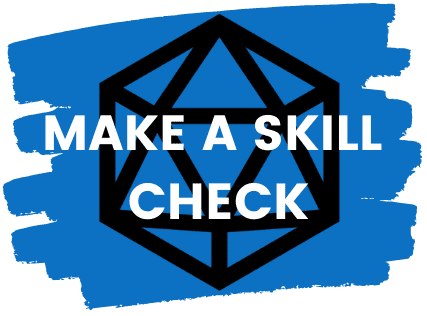On the go? Listen to the audio version of the article here:
Ready to start a brand-new D&D adventure? Fantastic! Or perhaps you’re re-rolling after some unfortunate mishaps—less… fantastic. Either way, it’s okay if you don’t know how to roll a new character! There’re plenty of options with three primary choices (two of which are alluded to in the Player’s Handbook (PHB, pg 12-13)). Let’s take a look:
There are 3 main ways: 1) Rolled/Manual—use 4d6, dropping the lowest dice. Some roll each stat in order; others assign at will. 2) Point Buy—choose your stats using a budget of 27 points (more on this later). 3) Standard Array—use 15, 14, 13, 12, 10, and 8 to slow into your stats of choice.
For a more in-depth guide, read on!

Table of Contents
A Rules-As-Written (RAW) Guide to Rolling for Stats
Before we jump into the how of stat rolling, let’s keep in mind the why:
5e Stats Explained: Ability Scores and Modifiers
Allocation of your stats matters.
Each class usually has one primary attribute that is most beneficial (such as Intelligence for a wizard) and two-ish secondary stats that are helpful (usually these depend on what role your character plays). The rest are nice-to-haves, but often treated as “dump stats”—the lowest scores go to them because they’re not necessary (like Strength for wizards).
Each stat is given a modifier, which is set by this table (PHB pg 13):
| Ability Score | Ability Modifier |
| 1 | −5 |
| 2–3 | −4 |
| 4–5 | −3 |
| 6–7 | −2 |
| 8–9 | −1 |
| 10–11 | +0 |
| 12–13 | +1 |
| 14–15 | +2 |
| 16–17 | +3 |
| 18–19 | +4 |
| 20–21 | +5 |
| 22–23 | +6 |
| 24–25 | +7 |
| 26–27 | +8 |
| 28–29 | +9 |
| 30 | +10 |
Note that stats roll over on even numbers, which is important when you’re factoring in your racial bonuses or other boosts based on class or magic items. If you know you’ll get a +1 to something and have an odd number, you can round it up to the next level modifier.
For example, you rolled a 15 and you have a +1 from a racial bonus – instead of it being a +2, the extra 1 (making it 16) will give you a +3 instead.
These boosts are added to skills related to the ability, such as Athletics being affected by Strength. If you have a -1 in Strength, then all rolls with Athletics will have a -1 (assuming you aren’t proficient).
Rolling Manually for Stats
Rolling for random stats is definitely the most fun! There’s nothing as exhilarating as letting your dice bounce on the table, hoping that the odds are in your favor. Maybe you’ll end up with a God-King, or maybe you’ll end up with nothing but dump stats. Both can be fun–or at least entertaining.
To roll for each stat, roll four 6-sided dice (or 4d6 for short). Afterward, add the 3 highest dice to get your stat!
For example, let’s say my rolls are as follows: 5, 4, 3, 1.
The highest three dice are 5, 4, and 3, meaning my stat total is 12! You just have to repeat this process another five times to get your six stats!
Issues With Rolling Manual Stats
First, rolling random stats is a gamble. The best-case scenario has you winning 18 in all stats. At worst, it’s a miserable loss with 3 in all stats.
Don’t worry, though; there’s only a 0.077% chance of rolling four 1s or 6s, and the odds of doing that for every stat is stupidly low.
With these large variations, it might be hard for the Dungeon Master (DM) to adjust to the player’s ability scores. In short, you’re probably gonna die hilariously.
If you’re looking for something more casual and silly without a care for balance, rolling manually is the best way to go!
Point Buy
In Point Buy, you get to choose your stats with a budget of 27 points. Using these, you can “purchase” stats – referring to the costs in the table below.
| Ability Score | Cost |
| 8 | 0 points |
| 9 | 1 points |
| 10 | 2 points |
| 11 | 3 points |
| 12 | 4 points |
| 13 | 5 points |
| 14 | 7 points |
| 15 | 9 points |
As an example, I decide to spend 18 points to get two 15s. With 9 points left, I decided to get two 10’s and a 13. With no points left, my sixth and final ability score has to be 8.
My stats would look as follows:
15, 15, 13, 10, 10, 8.
Overall, Point Buy is an excellent way to roll for stats. It gives players more freedom and flexibility in customizing their characters’ ability scores. Furthermore, it prevents extremes in scores, allowing it easier to balance encounters for both players and DMs!
If you struggle to calculate with Point Buy, not to worry—there’s an online calculator to make the job easy! As well, D&D Beyond also has this option built-in when making a character.
Standard Array
Your stats are automatically 15, 14, 13, 12, 10, and 8. All you have to do is select which score goes into which ability—easy peasy.
Though it is the least customizable, the Standard Array has several benefits.

First, the Standard Array provides consistency. If all players use the Standard Array, it ensures they start at the same level. Furthermore, the Standard Array is the fastest way; the scores are already set! All you have to do is assign them!
Personally, the Standard Array has always been my favorite, as both a DM and a player.
As a DM, it has ensured balanced, fun gameplay for my players and me. It also makes it easier for me to design encounters.
It may be the most boring way, but for me, it’s been the best!
Matt Colville Rules
As popularized by the amazing Youtuber himself, this one is pretty simple: roll 4d6 and drop the lowest stat. According to Matt, if all of your ability modifiers added together equals less than +2, then you redo the whole thing.
This has two slight variations; either you roll the Ability Scores in order, or you roll them all and choose where to slot them.
The first is more fun if you all like to randomly come up with players, but the second is better if you already have a preexisting idea.
Home Brew Rules for Rolling Stats
Of course, you don’t have to follow the RAW! Rules are just guidelines, and you’re free to tweak them as you see fit! Just make sure everyone agrees, specifically the DM.
Here are a couple of homebrew alternatives:
Group Rolling Stats
Similar to rolling solo, throw a total of 6 scores per player – with each score determined by dropping the lowest of 4d6 and adding the top three.
Rather than use these scores for yourself, however, you instead put them into a group pool. Talk with the other players to distribute the stats equally amongst yourselves!
Group rolling is a way to limit variation in each player’s stats. That way, if one player rolls high and another rolls poorly, they can exchange scores, allowing better balance.
Not-So-Unlucky Rule
If you decide to roll for stats but would like to keep stats relatively high, you can make players reroll any 1s that crop up. This makes random stat generation a lot less… debilitating.
Bigger Point Buy
If you like the control of Point Buy but want even more flexibility, there are homebrew rules for that. Why start with a measly 15 when you can begin a campaign with 19!
DMs and players alike have generated many ways to roll for stats. If you’d like to know all, here’s a community compiled list breaking down the approaches!
Summary
There are many ways to roll for stats, each with its pros and cons:
- Rolling/Manual: tossing 4d6 and adding the highest 3. This sometimes is done stat-by-stat or can be used to generate a pool of numbers you can put where you like.
- Point Buy: given a certain number of points to spend on boosting stats of your choosing.
- Standard Array: given a set of numbers, you can slot into any attribute you like. These standard numbers ate: 15, 14, 13, 12, 10, and 8.

Both Point Buy and the Standard Array allow balanced gameplay, whereas rolling manually is more casual. Of course, if you find these RAW methods boring – there’s plenty of homebrew guides! Just make sure you consult with your DM!







0 Comments
Trackbacks/Pingbacks